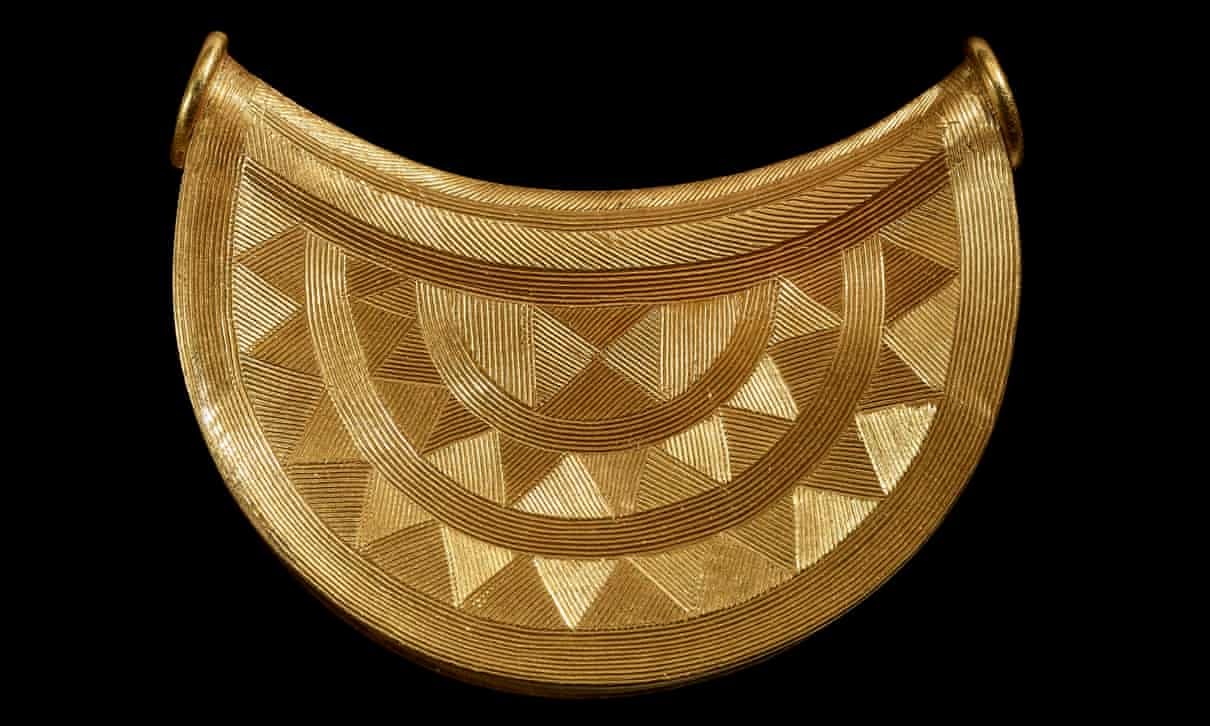LONDON – The British Museum announced this week that it has acquired a remarkable 3000 year old gold pendant, or bulla (the Latin for ‘bubble’), described as a ‘sun pendant’ since it shows a stylized image of the sun.
The Bronze Age item was found in a field in Shropshire by a metal detectorist in 2018 and handed over to the Finds Liaison Officer for Shropshire & Herefordshire, who notified the Coroner. It was then taken to the British Museum under the Treasure process.
The bulla was valued and cost the Museum £250,000: money was found from the Art Fund and the American Friends of the British Museum.
Neil Wilkin, the museum’s bronze age curator, says: “I was absolutely flabbergasted, I couldn’t believe my eyes. To me it is the most important object from this period, the first age of metal, that has come up in about 100 years… The skill and care with which it has been put together is remarkable. It is just exquisite.
The elegant form and brilliantly executed decoration of the sun pendant was accomplished with an ingenious skill. It tells us how important the sun – and its path through the sky during the course of the day and the year – was to people’s beliefs during this period. Its preservation is such that is difficult to believe that 3,000 years have passed between leaving its maker’s hand and being placed inside a museum case.”

The 3,000 year-old pendant [Courtesy: The British Museum]
Peter Reavill, Shropshire Council’s finds liaison officer, said: “The design is such that the play of light over the surface is what you would see most… shimmering, dancing and ever different [it would have been] stunning when viewed by firelight or in bright sunlight”.
The pendant will go on display from November at Shrewsbury museum and art gallery, near where it was found. It will be displayed in the British Museum in London next year along with other bronze age treasures. It is covered with geometric designs and is hollow: it seems that it had contents which are currently being analyzed by experts at the British Museum and which will be revealed in due course.

The geometric detail of the pendant [Courtesy: The British Museum]
The bulla, which measures 3.6cm by 4.7cm, bears a resemblance to Bronze Age decoration found on pieces of jewellery and bigger items such as the Trundholm Sun Chariot, now on display in Copenhagen. This was found in September 1902 during ploughing in the former bog of the Trundholm Mose in northwestern Zealand. A farmer spotted the beautiful horse lying in the mud and thought he had found an old toy. He brought it inside for his children but then realized that it was not a toy and got in touch with the National Museum of Denmark.
The Sun Chariot dates from the Early Bronze Age, in around 1400 BC and illustrates the idea that the sun was drawn on its eternal journey by a divine horse. An image of the sun and a horse were placed on wheels to symbolize the motion of the sun.The sun image appears in other places in Scandinavia, for instance in rock art and on little bronze objects. Razors are an example of these. Other mythological beings also carry the sun and not just horses: fish, ships, snakes and aquatic birds are also shown.
Nordic traditions from the 13th century onwards mention solar voyages, but seem from the prevalence of these images to be much older. The Nordic sun goddess Sól, for example, journeys through the sky in a chariot pulled by two horses.As with finds in the British landscape, Bronze Age Scandinavian inhabitants threw important items into lakes, pools and bogs. This is fortunate for us, as many of these items have thus become preserved. The Shropshire solar disc would not initially appear to fall into this category, since it was discovered in a field, but experts believe that the area in which it was found was watery and boggy in nature back in the Bronze Age. It is in excellent condition.
Another pendant, apparently similar, was found in the 1700s near Manchester and recorded in 1806, but has since been lost. Hartwig Fischer, director of the British Museum, said: “I am also personally delighted that the first public display of the object will be in Shropshire. This loan represents the start of a long-term partnership with our colleagues at Shrewsbury Museum and Art Gallery and will broaden our links with museum partners in the region.”
Fay Bailey, manager of Shropshire Museums, adds: “The Shropshire Marches Bulla is an unparalleled find of international significance. The discovery of this exceptional object and associated finds helps to deepen our understanding of Bronze Age Britain and confirms that Shropshire has an important story to tell.We are delighted to have the opportunity to establish a long-term partnership with colleagues from the British Museum whose commitment to our region will be invaluable as we redisplay our galleries and set prehistoric Shropshire in a wider, national context.”
The Wild Hunt is not responsible for links to external content.
To join a conversation on this post:
Visit our The Wild Hunt subreddit! Point your favorite browser to https://www.reddit.com/r/The_Wild_Hunt_News/, then click “JOIN”. Make sure to click the bell, too, to be notified of new articles posted to our subreddit.